How to turn a photo into a painting using the Generative Fill function in Photoshop
Step 1: Open your photo
Because the AI that generates the image always replaces the original image detail with new detail (even when applied at low intensity), the painting effect created with Generative Fill tends to work best on photos like landscapes and nature shots, where precise details are not as important as, say, someone's facial features.
So the tutorial will use this photo from Adobe Stock.
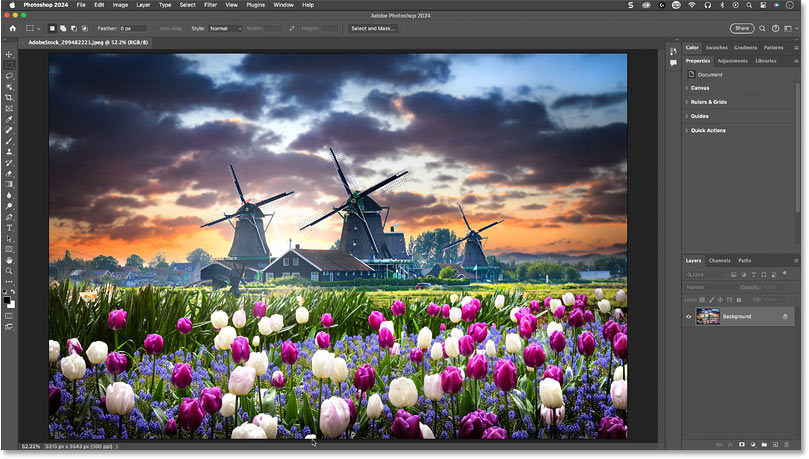
Step 2: Switch to Quick Mask mode
To apply a Generative Fill at less than 100% strength, you need to start in Photoshop's Quick Mask mode.
On the toolbar, click the Quick Mask icon (near the bottom, just below the color swatches). Or you can press the letter Q on your keyboard.

An easy way to know you're in Quick Mask mode is that the Background layer in the Layers panel is highlighted in red.

Step 3: Open Fill options
While Quick Mask mode is active, go to the Edit menu in the Menu bar and select Fill.
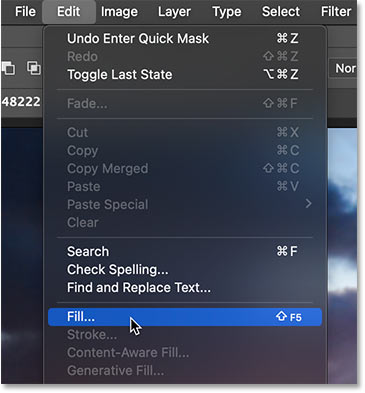
Step 4: Choose a dark gray fill color
In the Fill dialog box, change the Contents option to Color.
Note that even if a Color is already selected, you still need to select it again for the Color Picker to open.
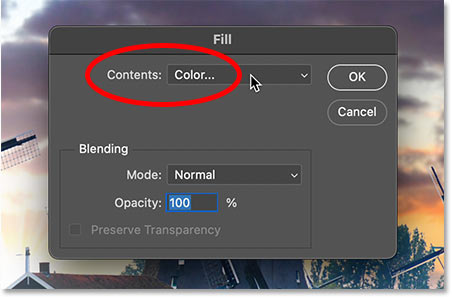
In the Color Picker, set the H (Hue) and S (Saturation) values to 0 to work with gray. Then set the B (Brightness) value to 30%.
Think of the luminance value as the AI intensity value. The higher the value, the more impact Generative Fill will have on the image (and the more the image will change). The lower the value, the more original detail will be preserved.
For this painting effect, 20 - 40% usually works best, and 30% tends to be the sweet spot. But you can always repeat these steps with different brightness values to compare results.
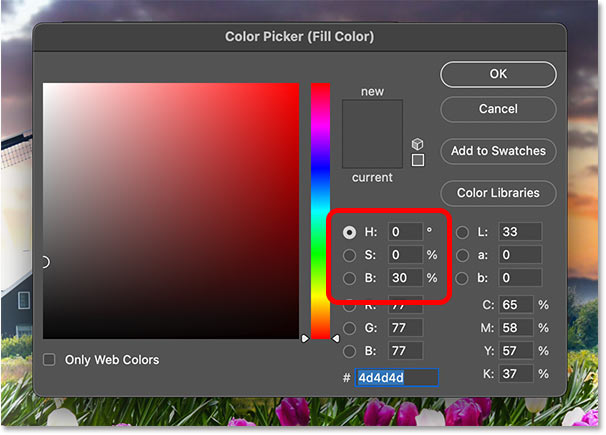
Step 5: Exit Quick Mask mode
Click OK to close Photoshop's Color Picker. Then click OK to close the Fill dialog box.
Since you're in Quick Mask mode, your image will appear with a red overlay (another easy way to tell you're in Quick Mask mode).
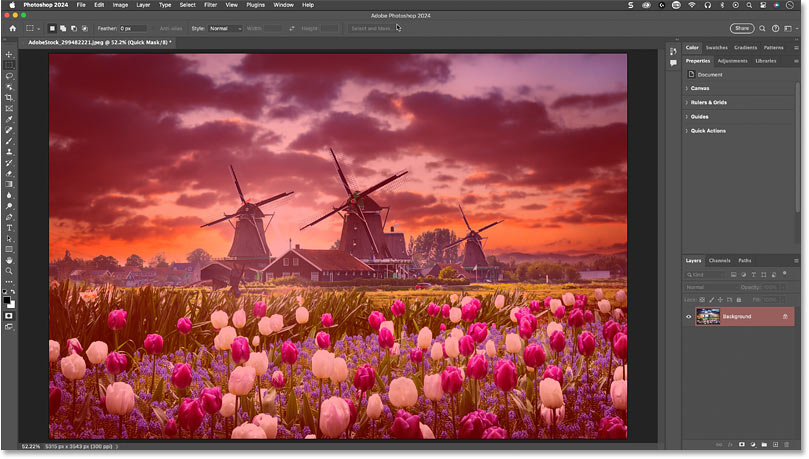
Exit Quick Mask mode by clicking the Quick Mask icon on the toolbar again or pressing Q on your keyboard.
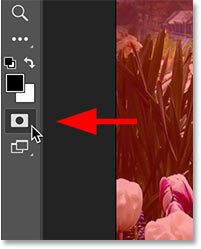
Step 6: Select Generative Fill
In Photoshop's Contextual Task Bar, click Generative Fill.

Step 7: Enter the drawing prompt and click Generate
In the prompt box, type the type of painting you want to create. For example, we'll type watercolor painting.
Then click Generate.

Step 8: Choose the best result
You will need to wait a few seconds for Photoshop and Adobe Firefly to generate the results.
This is the original watercolor effect. Applying Generative Fill at just 30% strength allows for a lot of the original detail to be retained so that the flowers and windmills can still be distinguished.
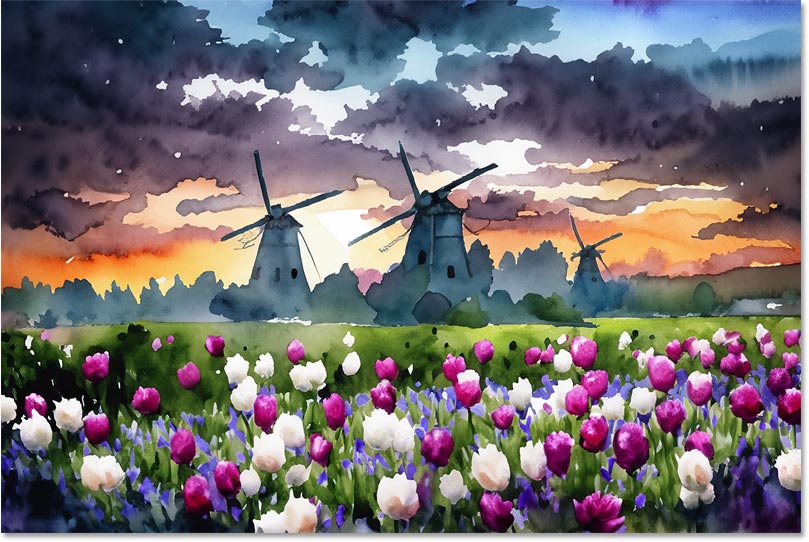
As usual with Generative Fill, you'll see three variations of the result in the Properties panel so you can choose the one you like best. Or click Generate to try again.
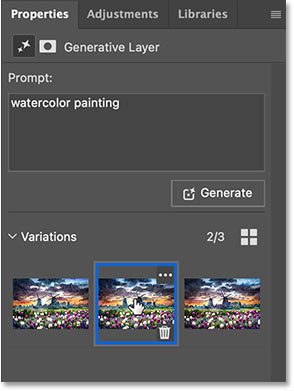
Step 9: Try different drawing styles
After creating the initial drawing effect, you can easily try out different drawing styles simply by changing the prompt in the Properties panel.
For example, change the prompt from watercolor to oil painting. Then click Generate.
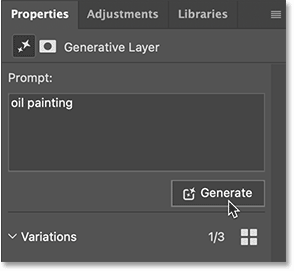
This is my favorite of the 3 oil painting results.
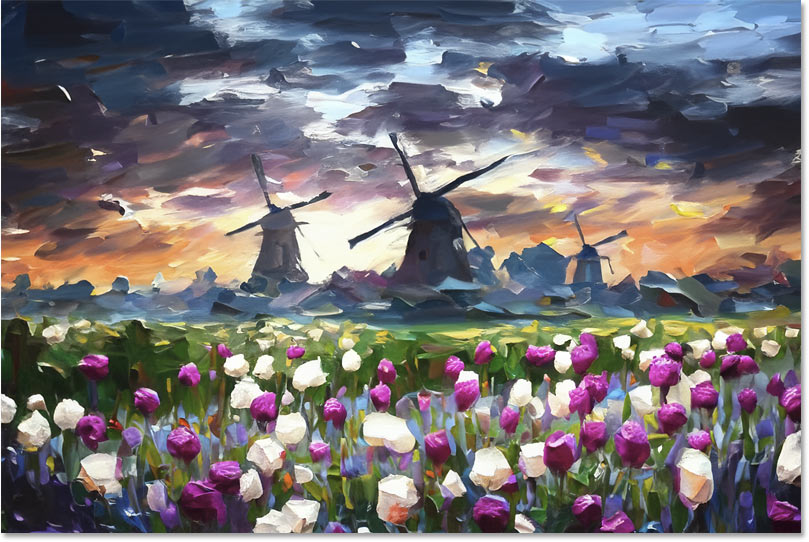
And that's it! That's how easy it is to turn a photo into a painting using Generative Fill in Photoshop.
You should read it
- How to blur photos using Adobe Photoshop Fix Android
- Link download Adobe Photoshop Express for Windows 10 3.0.316.0
- How to hide - show menu items in Adobe Photoshop
- Remove bad details from photos with Adobe Photoshop
- Instructions for using Photoshop CS5 to edit photos in full set
- How to use Photoshop CS5 - Part 1: Toolbox
- Adobe unveils 'touch' photoshop version
- New features of Photoshop CC 2019
May be interested
- Adobe Photoshop launches a series of AI tools
 at the max london creative conference, adobe launched a powerful photoshop update with many new, groundbreaking ai features built on the foundation of the previous generative fill tool.
at the max london creative conference, adobe launched a powerful photoshop update with many new, groundbreaking ai features built on the foundation of the previous generative fill tool. - How to create wall paintings in Photoshop
 with images available, you can turn into wall paintings right in photoshop.
with images available, you can turn into wall paintings right in photoshop. - 'Transform' a picture into an animated picture or picture using Adobe Photoshop
 in the article below, tipsmake.com will guide you how to turn the photo into a painting, so that it resembles the animated film, or is it cartoon. for portraits, this is quite interesting, as a result you will have a very lively, attractive and attractive image.
in the article below, tipsmake.com will guide you how to turn the photo into a painting, so that it resembles the animated film, or is it cartoon. for portraits, this is quite interesting, as a result you will have a very lively, attractive and attractive image. - Learn about Content Aware Fill in Adobe Photoshop CS5
 in the following article, we will introduce you some features of content aware fill feature in adobe photoshop. this is one of the incredible changes in cs5 version of today's most popular graphics application ...
in the following article, we will introduce you some features of content aware fill feature in adobe photoshop. this is one of the incredible changes in cs5 version of today's most popular graphics application ... - What is Generative AI?
 chatgpt, bing ai, and google bard are some of the most recognizable names in the world of consumer artificial intelligence. all 3 products have one thing in common - they are all generative ai products.
chatgpt, bing ai, and google bard are some of the most recognizable names in the world of consumer artificial intelligence. all 3 products have one thing in common - they are all generative ai products. - How to color images in Photoshop
 on photoshop, there is a simple color filler and photo filler tool.
on photoshop, there is a simple color filler and photo filler tool. - Instructions for using Photoshop CS5 to edit photos in full set
 although photoshop cs5 is not the latest photoshop version, it is quite popular among users. tipsmake.com has put a lot of effort into rearranging the tutorial series using adobe photoshop cs5 for new readers to learn and enjoy this set of photo editing tools. invite you to follow along.
although photoshop cs5 is not the latest photoshop version, it is quite popular among users. tipsmake.com has put a lot of effort into rearranging the tutorial series using adobe photoshop cs5 for new readers to learn and enjoy this set of photo editing tools. invite you to follow along. - How to use Photoshop CS6 (Part 1): Create digital photos
 this article will guide you through the steps to turn an ordinary photo into an eye-catching fashion photo using lighting effects and color correction in adobe photoshop cs6.
this article will guide you through the steps to turn an ordinary photo into an eye-catching fashion photo using lighting effects and color correction in adobe photoshop cs6. - Create digital photos with Photoshop CS6
 this article will guide you through the steps to turn an ordinary photo into an eye-catching fashion photo using lighting effects and color correction in adobe photoshop cs6.
this article will guide you through the steps to turn an ordinary photo into an eye-catching fashion photo using lighting effects and color correction in adobe photoshop cs6. - TOP Generative AI tools and applications by field
 from content creation to gaming, genai tools are revolutionizing processes, reducing manual effort and opening doors to limitless possibilities. here are the top generative ai tools and applications.
from content creation to gaming, genai tools are revolutionizing processes, reducing manual effort and opening doors to limitless possibilities. here are the top generative ai tools and applications.










 Photography rules to help improve photos taken with smartphones
Photography rules to help improve photos taken with smartphones Instructions to combine clouds into beautiful and simple photos using PicsArt
Instructions to combine clouds into beautiful and simple photos using PicsArt 6 mobile apps to help create double exposure effects
6 mobile apps to help create double exposure effects Convert black and white photos to color in the blink of an eye
Convert black and white photos to color in the blink of an eye 6 camera apps to help take better photos on smartphones
6 camera apps to help take better photos on smartphones How to animate photos, text, and graphics in Adobe Express
How to animate photos, text, and graphics in Adobe Express